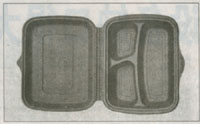3. Plant Straw and Nutshell Molded Tableware This kind of tableware is straw, wheat straw, peanut peel and other crop straws as raw materials, dried, crushed, added a suitable amount of adhesive, and then spray molded waterproof after warm molding , Oil-repellent coating and other manufacturing processes. Considering the comprehensive utilization of crop resources and environmental protection, such dishes are worthy of promotion and development. But so far, the product is brittle, poor adhesive strength, there is no definite toughness, the product is fragile, if it is not careful, it will be broken on the ground, inconvenient for long-distance transportation, the appearance of color gray talk, low yield, raw materials The residual pesticides in the can not be removed, so it is difficult to ensure safety, reliability and health in large-scale production.
4. Degradable plastic products One is a so-called biodegradable plastic. It is actually a plastic such as polyethylene. It is mixed with starch or other products. After use, the starch and other incorporation components are biodegraded, and the real plastic part is biodegraded. However, the real plastic part can not be degraded at all, and the amount of incorporation is also very limited, generally not exceeding 15%, so the replacement of “white pollution†by this biodegradable plastic is only a minor effect. The other is the so-called photodegradable plastic tableware, and the production material is still grafted with foamed polystyrene as a parent to modify some starch or add a small amount of photosensitizer and other reducing agents. Such utensils still take a long time in the natural environment to lighten, thin, and fragment the product and eventually become small pieces. Like the so-called biodegradable plastics, they cannot be truly degraded (that is, they cannot It is absorbed by the environment.) The broken pieces and powders form a net and play a role in the consolidation of the soil, affecting the land on which people depend. In short, biodegradable plastics are good, photodegradable plastics are also good, no matter how they are blended, in addition to starch and other incorporation materials are degraded, the rest of the plastic is still the same.

Second, the breakthrough of the full degradation of tableware In January 2000, Jiangsu Yangzhong City, Xinhua Town, Hua Peng Group, chairman Guo Dao Peng after repeated inspections that: paper disposable tableware is not suitable for promotion and application. The first is that the environmental pollution caused by papermaking is quite large and the cost is high. Second, the area of ​​forest on the earth is declining. There are fewer in our country and the environment is getting worse. As for other straws, rice straws, degradable plastics, etc., which are not really environmentally friendly products, the development of one-time edible thermoplastic starch full-degradable tableware with food is not only an environmentally friendly product, but also opens up a new crop for farmers' income-generating income. way. So attentive to study at any cost, and finally pays off, the one-time edible thermoplastic starch degradation tableware research success. Regardless of the process flow, equipment cost, product cost, degradation rate, and service performance, they passed the most authoritative national and environmental product quality supervision and inspection center inspections, and all the indicators were qualified. The products attracted the attention of foreign media at the 4th APEC Technology Exhibition. They said: The tableware revolution ignited by the Chinese has played a good role in helping the world step into a new world of food culture.
Disposable edible thermoplastic starch full-degradable tableware uses edible grains (flour, starch, rice flour, etc.) as raw materials, and is added with a variety of natural food substances, mixed and heated and pressed, and finally processed by "three resistances." Dry, sterilized. A variety of bowls, plates, cups, dishes, etc. can be produced by replacing the main mold. It can also produce instrumentation appliances and other shock-proof inner mat green environmental protection appliances, process schematic diagram: Mixing → quantitative cutting → blanking → “three resistance treatment†→ drying sterilization → packaging. (Finish)